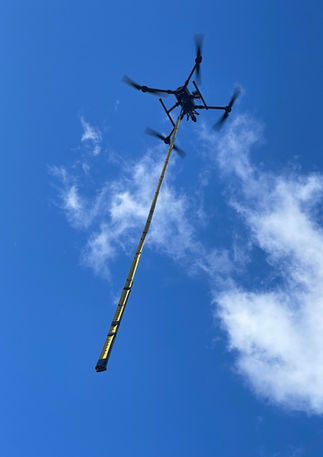
St. Croix River Maine-Canada Border
Mapping the Future of Fish Passage at the St. Croix River Dams
At Massachusetts Drone LiDAR, we take pride in utilizing cutting-edge drone technology to contribute to environmental conservation efforts. One of our projects involved the use of a drone-mounted bathymetric sensor to map the riverbed at the three major dams along the St. Croix River—Milltown, Woodland, and Grand Falls Dams. Additionally, we conducted LiDAR mapping of the shorelines and dam structures to support ongoing fish passage restoration efforts, particularly for alewives, a key species in the region's ecosystem.

The Importance of Fish Passage Restoration
The St. Croix River has long been a critical migratory pathway for alewives and other fish species, but the construction of dams over the past century has severely hindered their natural migration. Historically, millions of alewives migrated upstream to spawn, supporting a rich ecosystem and benefiting commercial and recreational fisheries. However, dam obstructions, including those at Milltown, Woodland, and Grand Falls Dams, have dramatically reduced these populations.
Recognizing the ecological and cultural importance of restoring these fish runs, numerous stakeholders—including the U.S. Fish and Wildlife Service, NOAA Fisheries, and local environmental groups—have come together to develop fishway improvements at key sites along the river, including these three dams.

Fish Passage Efforts at the St. Croix River Dams
Each of the three dams presents unique challenges to fish passage. The Milltown Dam, the first barrier from the estuary, has a fishway that has been a focus of restoration efforts. Woodland Dam, owned and operated by Woodland Pulp, LLC, has a 227-meter denil-style fish ladder installed in 1965. Grand Falls Dam, the last major barrier before the river branches, also has a fishway in need of improvements.
Recent funding and collaborative efforts have focused on upgrading fish passage at all three dams to ensure a more effective and sustainable alewife migration. Improved fishways will enable alewives to reach over 98% of their historic spawning habitat, significantly contributing to regional fisheries and ecosystem health.
Our Role: Drone-Based Bathymetric and LiDAR Mapping
Massachusetts Drone LiDAR contributed to this initiative by deploying our advanced drone-mounted bathymetric sensors and LiDAR technology to survey the riverbed, shorelines, and dam structures. These technologies allowed us to gather precise topographical data without the need for boat-based surveys, which can be time-consuming and environmentally disruptive.
Key benefits of our bathymetric and LiDAR surveys include:
-
High-Resolution Riverbed and Shoreline Mapping: Our data helps identify obstructions, sediment build-up, and flow patterns that impact fish movement.
-
Optimized Fishway Design: By providing accurate depth, contour, and structural measurements, our work supports engineers in refining fishway designs for improved efficiency.
-
Environmental Impact Assessment: Understanding riverbed and shoreline conditions helps assess potential ecological impacts of dam operations and restoration projects.

Looking Ahead
The restoration of alewife runs in the St. Croix River represents a significant step toward ecological balance and sustainable fisheries management. With projects like the fishway improvements at Milltown, Woodland, and Grand Falls Dams, we are witnessing a collective effort to correct past environmental disruptions and restore natural fish migrations.
At Active Intelligence, we are proud to support these conservation efforts through our expertise in drone-based data collection. By leveraging innovative technology, we can contribute valuable insights that aid in habitat restoration and species conservation.
Stay tuned for more updates on our environmental projects, as we continue to use drones to make a difference in ecological restoration and resource management!
Learn More
For more details on fish passage restoration efforts in the St. Croix River, check out these articles:








